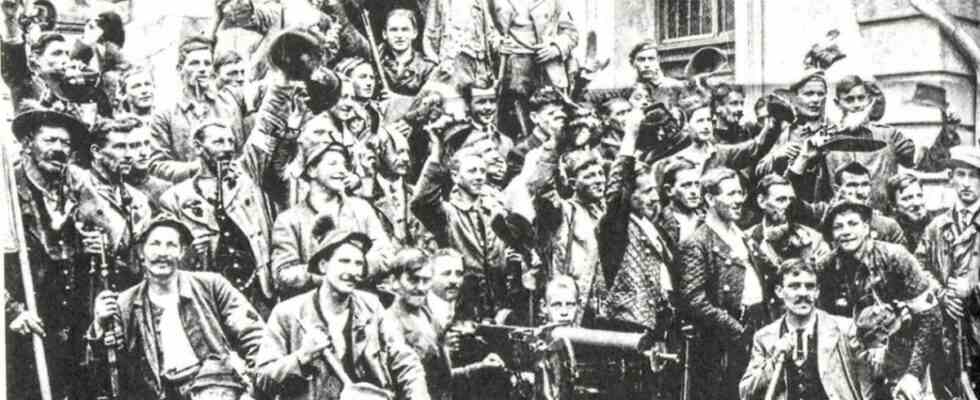There is by no means a lack of historical studies on the Weimar Republic. But what happened during this time in the Bavarian Oberland away from Munich has not been researched much or only for individual places. For the first time, nine authors, who have been researching in this area for years, have come together for the volume “Revolution and Reaction” in order to take a scientifically sound look at the period from 1919 to 1923 and, in a book that is consistently exciting to read, the beginnings of the trace the Nazi movement.
The volume begins with the November Revolution of 1918, which Dietrich Grund highlights. The uprising itself met with little response in southern Upper Bavaria. Unlike the Soviet Republic in April 1919: wherever there were workers, whether in the mining towns of Penzberg and Peiting or at the Walchensee power plant, which was currently under construction, revolutionary or workers’ councils were formed.
“Communist rule” everywhere, was the scent of Gustav von Kahr, district president of Upper Bavaria, at least if one believes his report to the Ministry of the Interior from June 1919, which is thankfully printed in full for the first time in the appendix. Arranged by location, he recorded the often bloody clashes, depicting the revolutionary actors as crude and uncivilized, only interested in bringing anarchy and Bolshevism to the provinces. Supported by the residents’ militia, he quickly succeeded in dissolving the workers’ and soldiers’ councils.
Incidentally, the historian Edith Raim considers the Bavarian residents’ militia to be the “missing link” between the mobile volunteer corps of 1919 and the SA, founded in 1921. Although the actual danger posed by a radicalized industrial workforce in the countryside was small, the Weir was immensely popular. Anyone who was “loyal to the government, physically fit and of good repute” could take part; members of the KPD and USPD were excluded. On the other hand, there were Jewish relatives; the military forces, which had to be dissolved in 1921, saw themselves as non-political and non-partisan.
The Weilheim Residents’ Guard in 1921.
(Photo: City Archive Weilheim)
That no longer applied to their paramilitary successors. After the failed Kapp-Lüttwitz Putsch (March 1920), Bavaria had become a “reception center for numerous dissolved Freikorps and counter-revolutionary organizations from all over Germany,” states Susanne Meinl, who deals with the beginnings of the brown networks in the Oberland. She evaluated the list of “Adolf Hitler’s comrades-in-arms” in the Federal Archives in Berlin[n] 1919-1921″, for them a “true treasure trove for brown local history”.
Thanks to Meinl’s meticulous research, it is possible to prove that the National Socialists quickly gained a foothold in the countryside. In September, Hitler joined the German Workers’ Party (DAP), one of the many radical right-wing splinter groups founded in January 1919. It was renamed the NSDAP in February 1920. Meinl discovered many names of businessmen and master craftsmen on the early membership list, almost all of whom were human who were respected in their places. Nevertheless, the local groups – the first in the Oberland was founded at Tegernsee – did not really want to gain momentum.
The rise of the NSDAP in the Oberland is examined using the example of the district office in Bad Tölz
The former Freikorps officers from northern Germany provided military know-how, above all the fighters of the “Marinebrigade Ehrhardt”. They were used for moorland cultivation in secret work details such as the Weilheim “Schmidt Working Group”. In reality, however – and with that they are very reminiscent of the current efforts of the Reich citizens – they prepared the violent elimination of the Weimar Republic, as Michael Hille writes, who examines the rise of the NSDAP in the Oberland using the example of the district office in Bad Tölz. Hitler himself rarely appeared in the Oberland, leaving the tedious advertising tour to his followers. Paul Hoser senses the activities of the party based on the articles in National Observer after.
Also extremely interesting is the essay by Michael E. Holzmann, which deals with the interactions between the ethnic movement in Austria and the Bavarian NSDAP and debunks the myth of Austria’s role as a victim. Gerhard Neumeier addresses the members of the NSDAP in Fürstenfeldbruck, Elisabeth Tworek analyzes tourism in the foothills of the Alps. And Gabi Rudnicki writes about the clairvoyant writer Ödön von Horváth.
After the failed coup of 8./9. On November 19, 1923 in Munich, the NSDAP was on the verge of dissolution. Hitler was in prison, the party itself was banned. But that did not stop the influx of the right-wing successor organizations.
Edith Raim/Susanne Meinl/Marion Hruschka/Ulrike Haerendel (eds.): Revolution and Reaction. The beginnings of the Nazi movement in the Bavarian Oberland from 1919 to 1923, Allitera Verlag. Book launch on January 26, 7 p.m., Evangelische Akademie Tutzing

